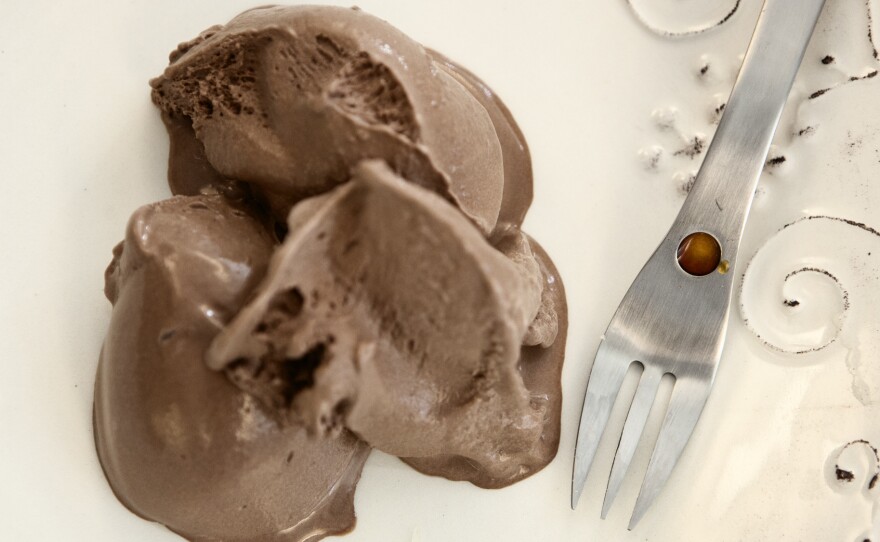

The flavors we savor are never just about taste.
Our tastebuds allow us to distinguish the basic characteristics of food, like sweet, salty, bitter and sour. But we use our noses to sense more subtle flavors. Our sense of smell is what allows us to savor fine wines, delicately seasoned broths and complex curries.
So is it possible to trick our brains into thinking we're tasting something, when we're only just smelling it?
Here at The Salt, we were intrigued when we realized that for 60 bucks, we could get a kit that would allow us to explore this idea for ourselves.
The "Aroma R-evolution" kit comes with four forks and 21 vials full of scents like passion fruit, wasabi and peanut. The idea is to drop a bit of scented liquid onto a paper tab inserted at the base of the fork. The smell that the fork emits is supposed to subtly flavor the food you eat while using the utensil.
"The fork is designed not so much to use as an everyday utensil but rather, a tool to experiment," explains Sophie Bovin of Molecule-R, the company that makes these kits. "It's interesting to try classic pairings," she says, and see if you can trick your brain into believing that baked potatoes scented with butter taste as good as baked potatoes with real butter.
But the real fun is in testing out unusual combinations, Bovin says, like chocolate with a wasabi scent, or broccoli with a strawberry scent.
So, in the name of science, Salt host Maria Godoy and I broke out the chocolate ice cream and started experimenting.
We decided to try the ice cream with three different scents: passion fruit, wasabi and smoke. We also tested out cheddar cheese with the smoke scent, butternut ravioli with the peanut, green beans with vanilla and lemons with banana. Here's how our Salt Lab experiments went:
Maanvi: The chocolate ice cream tastes good with just about everything. But chocolate with wasabi is the coolest pairing.
Maria: It tingles in my nose, like real wasabi would do. Although it probably works better than the real stuff, because that hits you much harder.
Cheddar paired with the smoke scent?
Maanvi: Delicious — it really did evoke the flavor of smoked cheese.
Maria: And the smoky sensation lingers in your mouth and throat for a while.
Some pairings were interesting, but not mind-blowing. The peanut scent subtly played up the sweetness in our butternut squash ravioli, and the vanilla scent distracted from the bitterness of the green beans.
Other scents just didn't work for us. Banana scent smelled more like acetone – you know, the stuff used to remove nail polish – than tropical fruit. In fact, the majority of the fruit scents smelled fake – more like a scratch-n-sniff sticker set than a tempting buffet for the nose.
Maria: It reminds me of one of those old scented Strawberry Shortcake dolls from the '80s.
When we sniffed all the vials, we noticed that some smelled a lot more authentic than others. The truffle was subtle and earthy, but the olive oil scent smelled rancid.
So how come our brains weren't totally tricked by this nifty fork?
Partly because some smells are extremely hard to replicate, says sensory psychologist Marcia Pelchat at the Monell Chemical Senses Center. "Usually any real food has hundreds of compounds responsible for [its distinctive] smell," she explains.
In the lab, scientists can analyze all these compounds and try to figure out which ones are most characteristic of a particular food.
"With wasabi, I think there's pretty much one compound that makes it smells like that," Pechat says. Citrus is also usually pretty easy to replicate and bottle in the lab. Most fruit scents, however, are very difficult to pin down, Pelchat says.
Even with entirely accurate aromas, tricking the brain with scent isn't as easy as it may seem. That's because of the way in which we smell, Pelchat says.
When we sniff something, we breathe in the chemicals responsible for scent through our nostrils. That's called "orthonasal olfaction," Pelchat explains.
Tasting involves a different type of smelling, called retronasal olfaction. "The nose and the mouth are connected. During eating, the tongue and palette push air upward into the nose. And that's what produces the sensation of flavor," Pelchat says.
To trick our brains into thinking we're tasting something that isn't really there, the Aromafork would have to engage our retronasal mechanism. But since most of us use only the tip of the fork to eat, the Aromafork's scents don't get deep enough inside our mouths.
That's why, when we tried the smoke scent with ice cream, it felt a bit like we were eating ice cream while sitting next to someone who was chowing on barbeque.
Our verdict: This fork probably isn't going to revolutionize the way we eat, though it did make for a fun afternoon of tasting. As Maria put it, "It's like a board game for foodies."
*Note: Our original headline was Smelly Fork, Smelly Fork, What Are You Feeding Us? In case that left you puzzled, it's an homage to this.
Copyright 2014 NPR. To see more, visit http://www.npr.org/.






